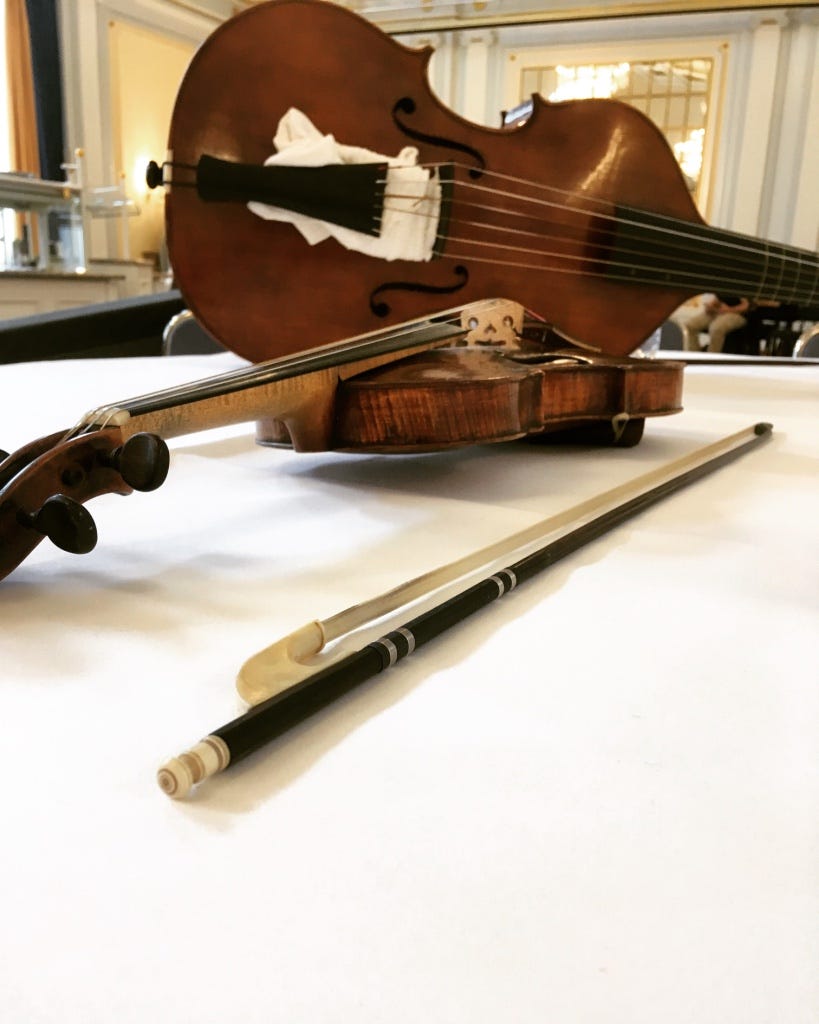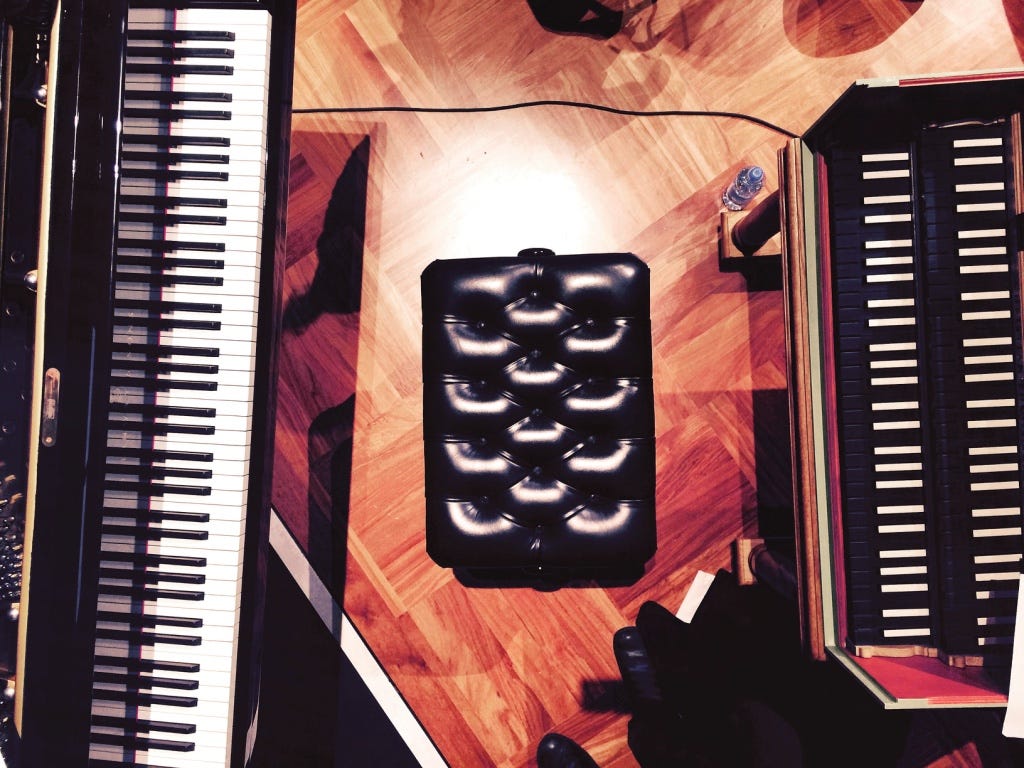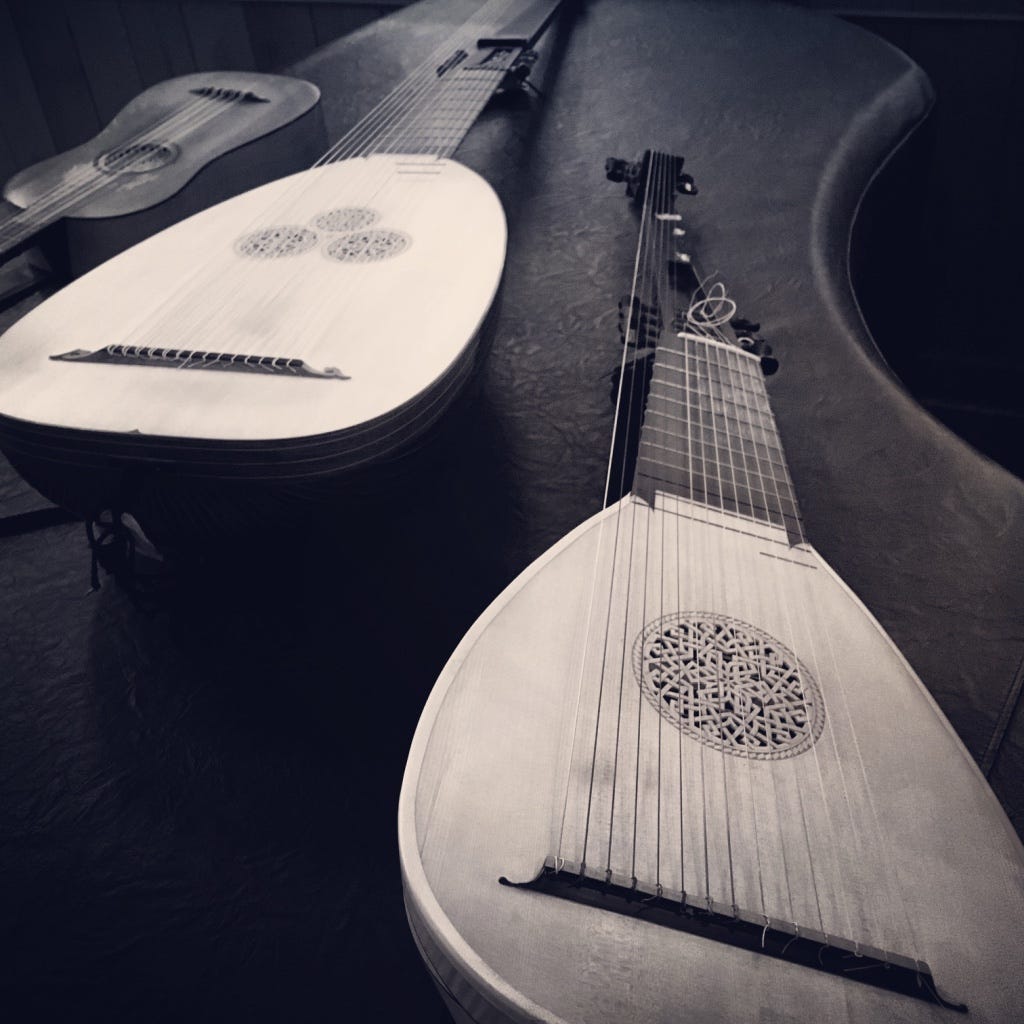When I was a student at the Royal Conservatory of the Hague in the Netherlands, I was invited by a friend of a friend to attend a performance of students of the early music department. I was studying jazz at the time and I was just dipping my toes into the world of classical music, but early music? I had no idea what that was, and I had only recently found out that there was a whole celebrated conservatory department dedicated to it, and people came from all over the world to study there. In my head I had this fantasy that I was going to experience a performance of prehistorical musical instruments, or at least a musical application of Pythagorean theories. Instead, as I entered the room and flicked through the concert program notes, I soon realised with slight disappointment that I was attending a concert of Bach violin sonatas. I interrogated my companion: “ If Bach is early music then how is this different from what are they playing in the classical music department?” She replied “Oh no…it’s completely different!”, but the concert was about to begin, so we couldn’t really continue our conversation. After the performance we sat in front of a beer and my friend explained to me: “There are so many differences between the classical music department and the early music department, but I will start with some major ones:
The musical instruments
The instruments on stage were a violin, a harpsichord and an instrument that looked like a cross between a cello and a double bass, but with frets (I later learned it was a bass viol). They were a little different than usual classical instruments, but nothing looked completely out of the ordinary. My friend told me that the instruments were exact copies of instruments from the 18th century. Nothing new there either, I thought… “aren’t most celebrated classical string players performing on 17th and 18th century instruments? so what’s the difference? I only heard the other day about the great Russian virtuoso who plays a Stradivarius violin!”. She replied “Are you aware that the body of that Stradivarius instrument is about the only thing that looks like a 17th century violin? That instrument has been completely modified to be played by modern violin players. In a copy of a baroque instrument the setup is different, the strings are made of gut instead of wound steel, usually there is no shoulder or chin rest and finally the bow is entirely different in shape, size and weight. The instrument you saw on stage is much more similar to the instrument that Bach wrote that music for”.

Later I did eventually find out that in the early music world there are indeed a lot of crazy looking, exotic and beautiful sounding instruments. I feel that the beauty of sound of these instrument combined is probably one of the strongest reasons why I am so attracted to the music of the late renaissance and early baroque.
If you want to know more about the instruments you should check this channel with great short videos on each instrument made by the musicians of the Orchestra of the age of enlightenment.
The performance practice
She continued by explaining that in the early music department, you are expected to play music and research music in equal parts. You are supposed to find and read all the historical treatises and deduct a performance practice that is (in theory) more similar to how it might have been back then when this music was written. She reminded me that most of the musicians in the classical music department come from a “romantic” classical music training, and she added with a hint of disgust that they usually perform baroque music in the same way they would perform Schubert and Brahms.
I was intrigued and asked for more details. “In romantic performance practice”, she said, “everything is slow, affected and heavy. The performers often use a continuous huge vibrato which is vital part of their sound, and that’s just the beginning of it”.
Now that I understand exactly what she was talking about, I can try to give you a concrete example by sharing with you two very different recordings of the same piece of music from the 17th century.
Listen to the first 20 seconds of the first recording. It’s a “modern” orchestra playing an Adagio from a Corelli Concerto Grosso. Listen to the vibrato on the strings and listen to the weight of each chord.
Then compare it to the second recording of the same piece performed on historical instruments by an early music group.
You might find it hard to believe it’s the same piece of music! The differences are striking. The chords are gentle, light and full of beautiful colours. The solo violins are adding ornaments and flourishes to go from one chord to the next, giving a very improvisatory quality and movement to the music.
Fast forward to five years later and I am sitting down at a harpsichord, performing in one of the most beautiful concert venues in Paris with one of the most celebrated early music ensembles in Europe!
So what happened in those five years and what made me fall in love with “early music?”
I was intrigued by the information my friend shared with me after the concert, but to me it still all sounded like a variation on the theme of classical music conservatory studies.
I got “bitten by the bug” and truly fell in love with the idea of early music only a few years later, and it started when I discovered the concept of “basso continuo”.
Basso Continuo
“Basso continuo” is the Italian expression for figured bass, ie the art of improvising an accompaniment from a bass line and chord symbols. This technique appeared in “western art music” in the late 16th century and continued well into the 19th century.
I was very curious about this concept as it resonated with my practice of Jazz piano very deeply (we also improvise accompaniments from chord symbols).
I was lucky enough to meet and become friends with one of the harpsichord teachers at the Royal Conservatory of The Hague (Patrick Ayrton) and together we started meeting regularly to exchange ideas and information on the art of basso continuo and the art of jazz comping. For me these were two cousin languages that ultimately aimed to reach different results but with a very similar mindset.
During that period I also realised that improvisation is supposed to play a very important role in the performance of early music.
Musicians not only improvised accompaniment in the form of basso continuo, they also improvised melodically over bass lines and developed a very complex style of ornamentation and diminutions.
So I was hooked, and I started digging into the improvisational languages of the Italian late 16th century and early 17th century, of a period of music that I was very attracted to from an aesthetic point of view.
Improvisation
For me the similarities between jazz musicians and the musicians from the 17th century were striking:
All musicians improvised
All musicians wrote their own music and performed it. There was hardly any difference between composers and performers.
Notated music was often a bare sketch to a much more complex performance, full of improvisation and variations.
There was a set core repertoire of “standards” that everybody knew and could improvise upon.
A big part of of the “standard” music repertoire was very rhythmical and inspired by dance rhythms and structures that were very popular at the time.
Unfortunately one of the biggest weaknesses of the celebrated early music department of The Hague was in fact improvisation. Nobody really taught it, and as I started investigating it, I discovered that the students had more questions than answers.
I was disappointed at first, but then I realised that most “early music” musicians do come indeed from classical conservatory training, so they are not familiar with the idea of improvisation in general, and they don’t know how to learn it and how to teach it. Since I came from an improvisational language and training myself, I thought I had probably better chances of understanding and dissecting the improvisational language of early baroque music.
So I started running my own jam sessions at the early music department and people who were interested in jamming on 17th century standards came by every Saturday to have a go. We were improvising on the simpler standards, mostly bass lines that were derived from dance forms.
But in the late 16th century the improvisation level was incredibly high, and musicians often improvised on pretty complex polyphonic vocal compositions.
Let me give you one practical example: the madrigal “Ancor che col partire” by Cipriano da Rore was a hit of the day, you could quote the first three notes and everyone knew what you were about to play. Listen to it here
We know that musicians improvised complex variations over vocal polyphony because the best improvisers of the time actually wrote instruction manuals on “how to learn to improvise”. These books are very similar to the contemporary educational books called “patterns for jazz” and they give you, for example, 20 variations on how to play a cadence (in jazz it would be 20 licks on a II V I cadence).
At the end of these books you find often a complete transcription of a solo by the author on one of the famous standards of the time (If these weren’t jazz cats then i don’t know…).
Listen to Francesco Rognoni’s viol solo on “Ancor che col partire” here performed by my friend, viol virtuoso Rodney Prada
And now listen to a contemporary set of variations, performed by the amazing cornetto player Doron Sherwin. Here he plays his own diminutions (this is what they called these florid improvised lines) on the same standard.
(The cornetto was the most beautiful wind instrument of the renaissance and early baroque periods. Think it as a cross between a trumpet and a recorder. Back in the day they said it was the most difficult instrument to play and the closest instrument to the human voice. It disappeared in the 18th century).
Historical performance practice
During one of these jam sessions, harpist and theorbo player Christina Pluhar came by. She was one of the faculty professors and she is the founder of celebrated early music ensemble L’Arpeggiata. We started talking about improvisation and shared our love for 17th century Italian music. A few months later she asked me if I would join her ensemble. All of a sudden I was catapulted onto big stages playing harpsichord with the best musicians on the scene. I suffered of a heavy case of “impostor syndrome” and I was quite terrified of having to play on an instrument that I had never even studied properly. It took me a long time to understand that probably I was there because I could improvise and because I wasn’t afraid of trying something different.
L’Arpeggiata was known as a quite extreme crossover early music group and was scorned by many early music purists. Many students expressed their dislike of the ensemble and when I asked them about their reasons, the answer was always “that’s not the way that music is supposed to sound…and it’s too jazzy and not serious enough”.
I thought to myself “fair enough if you don’t like it… we all have our own taste after all”. But saying that it doesn’t sound the way it is supposed to sound didn’t make any sense to me. Everyone around seemed to have very clear ideas about how 17th century music was supposed to sound, but they were missing one crucial passage: they never heard it!
Know everything, do your thing
The more I dug into the idea of historical performance practice, the more I actually realised that a similar mindset could be applied to many different types of music.
So nowadays it’s not uncommon to hear Chopin’s music performed on 19th century Erard pianos and with some improvised embellishments, to hear orchestral Debussy with early 20th century wind instruments and even Duke Ellington with period brass instruments.
So where does historical performance practice start? How close to us can you get and still call it historical performance practice?
I had been reflecting on this question for a long time when I had a revelation while listening to some early 20th century recordings of classical music. What struck me was that the performance practice was so different from any contemporary recordings I had heard of that music. There actually are recordings of composers themselves playing their own music for much of what has become 20th century canon, from Debussy to Stravinsky to Rachmaninov. Yet nobody is taking those as models and contemporary performances sound quite different from what the composers intended. In those old recordings the timing and sense of rubato were very different, the tempi were moving quicker and lighter, there was almost no vibrato and there was a general sense of lightness compared to what has become the standard of romantic performance. This seemed to be the case for piano, vocal and orchestral music alike.
If you are interested in exploring this further you should check this great video that compares old and contemporary recordings of romantic music
So the question I had to ask myself was: If we know what the music is supposed to sound like from recordings of the composers themselves or from people who actually learned from and worked with them, then why don’t we take that as example?
I came to the conclusion that the concept of historical performance practice starts when we don’t actually know how the music sounded. The beginning of the recording era is where we have to draw the line, before then we have no actual sound documentation and that opens up a whole universe of “made up” music. Of course we have the notes and a wealth of information on the music and the composers, but what does that actually mean?
I often use the example of jazz and I ask my students: “Imagine there were no recordings of Charlie Parker, but we had many of his transcribed solos and many written accounts and reviews of his gigs, would we actually have a clue of what he sounded like?”. The answer is of course no, how could we know about his swing feel, about his tone, his phrasing and articulation, the urge of his 16th notes runs?
Check out all the nuances of Charlie Parker improvised solo vs the very limited information transcribed on paper in this video
So when we are dealing baroque music, we actually have no idea of what the music sounded like…literally no idea… but that only enhances the fact that we will have more freedom when we go about recreating it.
What by now has become convention in baroque music is a language that was pretty much created by the early music pioneers of the 70’s and 80’s, mostly Dutch and Belgian musicians that started the early music movement as a counter culture reaction to the post romantic music education and performance models. They were the first ones to translate into music the information from the treatises, and even if nowadays nobody plays like them anymore (taste has already changed even within the early music movement!), their playing is still the starting reference point for everyone.
Furthermore I am actually convinced that if we could hear what the music actually sounded like in the time of Monteverdi, we would probably not like it. Let’s face it, we make music for contemporary ears, and everything has changed so much! The soundscapes of our world and probably even our bodies have changed in 500 years. The further we go back, the less we know and the more we can actually (re)create. So keep that in mind when you listen to a performance of say medieval music, you’re probably listening to a performance of contemporary music with an input from the Middle Ages.
When approaching historical performance practice my personal credo is very similar to the one I use for all other kinds of music I am interested in:
Put all the energy into research and read everything you need to know about it, but then make your own decisions and play the way your ears want the music to sound like. Aka“know everything, do your thing”.










Wow. Thanks for walking us thru your explorations
Thank you for this great music nerd post! I love "early music" (especially Jordi Savall) but didn't know any of the context you explain here, other than "played on period instruments". As a non-musician with no music education, I find your reflections on different aspects of musical interpretation and performance especially fascinating.